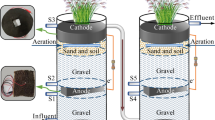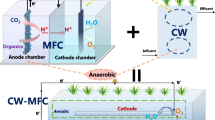Abstract
Three identical sets of constructed wetland-microbial fuel cells (CW-MFCs) fabricated with biomass carbon source addition were constructed and underwent the short- and long-term experiments. For this, the efficacy of biomass dosage and Pb(II) concentration towards Pb(II) removal and concurrent bioelectricity production of CW-MFCs were systematically explored. From the perspective of integrated capabilities and economic benefits, the solid biomass carbon sources equivalent to 500 mg/L COD was regarded as the optimal dosage, and the corresponding device was labeled as CW-MFC-2. For the short-term experiment, the closed-circuit CW-MFC-2 produced maximum output voltages and power densities in a range of 386–657 mV and 1.55 × 103–6.31 × 103 mW/m2 with the increasing Pb(II) level, respectively. Also, Pb(II) removal up to 94.4–99.6% was obtained in CW-MFC-2. With respect to long-term experiment, Pb(II) removal, the maximum output voltage, and power density of CW-MFC-2 ranged from 98.7 to 99.2%, 322 to 387 mV, and 3.28 × 102 to 2.26 × 103 mW/m2 upon 200 mg/L Pb(II) level, respectively. The migration results confirmed the potential of substrate and biomass for Pb(II) adsorption and fixation. For the cathode, Pb(II) was fixed and removed via binding to O. This study enlarges our knowledge of effective modulation of CW-MFCs for the treatment of high-level Pb(II)-containing wastewater and bioelectricity generation via adopting desirable biomass dosage.





Similar content being viewed by others
Data availability
Not applicable.
References
Abourached C, Catal T, Liu H (2014) Efficacy of single-chamber microbial fuel cells for removal of cadmium and zinc with simultaneous electricity production. Water Res 51:228–233. https://doi.org/10.1016/j.watres.2013.10.062
Apollon W, Rusyn I, González-Gamboa N et al (2022) Improvement of zero waste sustainable recovery using microbial energy generation systems: a comprehensive review. Sci Total Environ 817:153055. https://doi.org/10.1016/j.scitotenv.2022.153055
Azimi A, Azari A, Rezakazemi M, Ansarpour M (2017) Removal of heavy metals from industrial wastewaters: a review. ChemBioEng Rev 4:37–59. https://doi.org/10.1002/cben.201600010
Dai M, Zhou G, Ng HY et al (2019) Diversity evolution of functional bacteria and resistance genes (CzcA) in aerobic activated sludge under Cd(II) stress. J Environ Manag 250:109519. https://doi.org/10.1016/j.jenvman.2019.109519
Di L, Li Y, Nie L et al (2020) Influence of plant radial oxygen loss in constructed wetland combined with microbial fuel cell on nitrobenzene removal from aqueous solution. J Hazard Mater 394:122542. https://doi.org/10.1016/j.jhazmat.2020.122542
Ebrahimi A, Sivakumar M, McLauchlan C et al (2021a) A critical review of the symbiotic relationship between constructed wetland and microbial fuel cell for enhancing pollutant removal and energy generation. J Environ Chem Eng 9:105011. https://doi.org/10.1016/j.jece.2020.105011
Ebrahimi A, Sivakumar M, McLauchlan C (2021b) A taxonomy of design factors in constructed wetland-microbial fuel cell performance: a review. J Environ Manag 291:112723. https://doi.org/10.1016/j.jenvman.2021.112723
El Mouden A, El Messaoudi N, El Guerraf A et al (2023) Removal of cadmium and lead ions from aqueous solutions by novel dolomite-quartz@Fe3O4 nanocomposite fabricated as nanoadsorbent. Environ Res 225:115606. https://doi.org/10.1016/j.envres.2023.115606
Fang Z, Song H, Yu R, Li X (2016) A microbial fuel cell-coupled constructed wetland promotes degradation of azo dye decolorization products. Ecol Eng 94:455–463. https://doi.org/10.1016/j.ecoleng.2016.06.020
Gupta S, Patro A, Mittal Y et al (2023) The race between classical microbial fuel cells, sediment-microbial fuel cells, plant-microbial fuel cells, and constructed wetlands-microbial fuel cells: applications and technology readiness level. Sci Total Environ 879:162757. https://doi.org/10.1016/j.scitotenv.2023.162757
Han H, Song P, Cai Z et al (2022) Immobilizing chromate reductase NfoR on magnetic biochar reduced Cr(VI) in copper-containing wastewater. J Clean Prod 361:132118. https://doi.org/10.1016/j.jclepro.2022.132118
Işık G, Saz Ç, Türker OC et al (2020) Boron removal with microcosm constructed wetlands (MCWs) with Carex divisa for treating contaminated river water. Arab J Geosci 13:541. https://doi.org/10.1007/s12517-020-05539-9
Jia K, Feng Q, Zhang G et al (2017) Understanding the roles of Na 2 S and Pb(II)in the flotation of hemimorphite. Miner Eng 111:167–173. https://doi.org/10.1016/j.mineng.2017.06.010
Kumar A, Kumar A, Cabral-Pinto MMS et al (2020) Lead toxicity: health hazards, influence on food chain, and sustainable remediation approaches. Int J Environ Res Public Health 17:2179. https://doi.org/10.3390/ijerph17072179
Latip SNHM, Damanhuri SNA, Ibrahim ND et al (2022) Utilization of water hyacinth in constructed wetlands for wastewater treatment. IOP Conf Ser Earth Environ Sci 1105:012032. https://doi.org/10.1088/1755-1315/1105/1/012032
Li Y, Wang S, Li Y et al (2018) Corn straw as a solid carbon source for the treatment of agricultural drainage water in horizontal subsurface flow constructed wetlands. Water 10:511. https://doi.org/10.3390/w10040511
Li H, Xu H, Song H-L et al (2020) Antibiotic resistance genes, bacterial communities, and functions in constructed wetland-microbial fuel cells: responses to the co-stresses of antibiotics and zinc. Environ Pollut 265:115084. https://doi.org/10.1016/j.envpol.2020.115084
Lim BS, Lu H, Choi C, Liu ZX (2015) Recovery of silver metal and electric power generation using a microbial fuel cell. Desalin Water Treat 54:3675–3681. https://doi.org/10.1080/19443994.2014.923191
Logroño W, Pérez M, Urquizo G et al (2017) Single chamber microbial fuel cell (SCMFC) with a cathodic microalgal biofilm: a preliminary assessment of the generation of bioelectricity and biodegradation of real dye textile wastewater. Chemosphere 176:378–388. https://doi.org/10.1016/j.chemosphere.2017.02.099
Lu R, Chen Y, Wu J et al (2022) In situ COD monitoring with use of a hybrid of constructed wetland-microbial fuel cell. Water Res 210:117957. https://doi.org/10.1016/j.watres.2021.117957
McGettrick JD, Hooper K, Pockett A et al (2019) Sources of Pb(0) artefacts during XPS analysis of lead halide perovskites. Mater Lett 251:98–101. https://doi.org/10.1016/j.matlet.2019.04.081
Mohammed A, Babatunde AO (2017) Modelling heavy metals transformation in vertical flow constructed wetlands. Ecol Model 354:62–71. https://doi.org/10.1016/j.ecolmodel.2017.03.012
Moradian JM, Fang Z, Yong Y-C (2021) Recent advances on biomass-fueled microbial fuel cell. Bioresour Bioprocess 8:14. https://doi.org/10.1186/s40643-021-00365-7
Qiu D, Liu S (2021) Degradation of azo dye wastewater by the combination process of 3D BER and CW-MFC. IOP Conf Ser Earth Environ Sci 675:012017. https://doi.org/10.1088/1755-1315/675/1/012017
Saz Ç, Türe C, Türker OC, Yakar A (2018) Effect of vegetation type on treatment performance and bioelectric production of constructed wetland modules combined with microbial fuel cell (CW-MFC) treating synthetic wastewater. Environ Sci Pollut Res 25:8777–8792. https://doi.org/10.1007/s11356-018-1208-y
Shahrokhi-Shahraki R, Benally C, El-Din MG, Park J (2021) High efficiency removal of heavy metals using tire-derived activated carbon vs commercial activated carbon: Insights into the adsorption mechanisms. Chemosphere 264:128455. https://doi.org/10.1016/j.chemosphere.2020.128455
Shen X, Zhang J, Liu D et al (2018) Enhance performance of microbial fuel cell coupled surface flow constructed wetland by using submerged plants and enclosed anodes. Chem Eng J 351:312–318. https://doi.org/10.1016/j.cej.2018.06.117
Siddiqui S, Bhatnagar P, Dhingra S et al (2023) Wastewater treatment and energy production by microbial fuel cells. Biomass Convers Biorefinery 13:3569–3592. https://doi.org/10.1007/s13399-021-01411-2
Song H, Zhang S, Long X et al (2017) Optimization of bioelectricity generation in constructed wetland-coupled microbial fuel cell systems. Water 9:185. https://doi.org/10.3390/w9030185
Tao M, Jing Z, Tao Z et al (2021) Improvements of nitrogen removal and electricity generation in microbial fuel cell-constructed wetland with extra corncob for carbon-limited wastewater treatment. J Clean Prod 297:126639. https://doi.org/10.1016/j.jclepro.2021.126639
Tao M, Jing Z, Tao Z et al (2022) Efficient nitrogen removal in microbial fuel cell – constructed wetland with corncobs addition for secondary effluent treatment. J Clean Prod 332:130108. https://doi.org/10.1016/j.jclepro.2021.130108
Tao M, Kong Y, Jing Z et al (2023) Acorus calamus recycled as an additional carbon source in a microbial fuel cell-constructed wetland for enhanced nitrogen removal. Bioresour Technol 384:129324. https://doi.org/10.1016/j.biortech.2023.129324
Türker OC, Türe C, Yakar A, Saz Ç (2017) Engineered wetland reactors with different media types to treat drinking water contaminated by boron (B). J Clean Prod 168:823–832. https://doi.org/10.1016/j.jclepro.2017.09.067
Wang F, Zhang D, Shen X et al (2019) Synchronously electricity generation and degradation of biogas slurry using microbial fuel cell. Renew Energy 142:158–166. https://doi.org/10.1016/j.renene.2019.04.063
Wang Q, Lv R, Rene ER et al (2020) Characterization of microbial community and resistance gene (CzcA) shifts in up-flow constructed wetlands-microbial fuel cell treating Zn (II) contaminated wastewater. Bioresour Technol 302:122867. https://doi.org/10.1016/j.biortech.2020.122867
Wang Z, Jiang Y, Mo X et al (2021) Speciation transformation of Pb during palygorskite sorption-calcination process: implications for Pb sequestration. Appl Geochem 124:104850. https://doi.org/10.1016/j.apgeochem.2020.104850
Wang L, Xu D, Zhang Q et al (2022) Simultaneous removal of heavy metals and bioelectricity generation in microbial fuel cell coupled with constructed wetland: an optimization study on substrate and plant types. Environ Sci Pollut Res 29:768–778. https://doi.org/10.1007/s11356-021-15688-3
Wen H, Zhu H, Xu Y et al (2021) Removal of sulfamethoxazole and tetracycline in constructed wetlands integrated with microbial fuel cells influenced by influent and operational conditions. Environ Pollut 272:115988. https://doi.org/10.1016/j.envpol.2020.115988
Xu L, Zhao Y, Doherty L et al (2016) Promoting the bio-cathode formation of a constructed wetland-microbial fuel cell by using powder activated carbon modified alum sludge in anode chamber. Sci Rep 6:26514. https://doi.org/10.1038/srep26514
Xu L, Zhao Y, Tang C, Doherty L (2018) Influence of glass wool as separator on bioelectricity generation in a constructed wetland-microbial fuel cell. J Environ Manag 207:116–123. https://doi.org/10.1016/j.jenvman.2017.11.035
Yakar A, Türe C, Türker OC et al (2018) Impacts of various filtration media on wastewater treatment and bioelectric production in up-flow constructed wetland combined with microbial fuel cell (UCW-MFC). Ecol Eng 117:120–132. https://doi.org/10.1016/j.ecoleng.2018.03.016
Yu G, Wang G, Li J et al (2020) Enhanced Cd2+ and Zn2+ removal from heavy metal wastewater in constructed wetlands with resistant microorganisms. Bioresour Technol 316:123898. https://doi.org/10.1016/j.biortech.2020.123898
Zhang Q, Wang L, Xu D et al (2022) Optimization of biomass carbon sources for simultaneous Pb(II) removal and bioelectricity generation in microbial fuel cell: based on agricultural waste types and pretreatment approaches. Biomass Convers Biorefinery. https://doi.org/10.1007/s13399-022-03451-8
Zhao C, Shang D, Zou Y et al (2020) Changes in electricity production and microbial community evolution in constructed wetland-microbial fuel cell exposed to wastewater containing Pb(II). Sci Total Environ 732:139127. https://doi.org/10.1016/j.scitotenv.2020.139127
Zhou Y, Xu D, Xiao E et al (2018) Relationship between electrogenic performance and physiological change of four wetland plants in constructed wetland-microbial fuel cells during non-growing seasons. J Environ Sci 70:54–62. https://doi.org/10.1016/j.jes.2017.11.008
Funding
This study was supported by the scientific research program of Anhui Provincial Education Department (KJ2021A0496), Anhui Polytechnic University Startup Foundation for Introduced Talents (2020YQQ059).
Author information
Authors and Affiliations
Contributions
DX formulated overarching research goals and aims. XT and LW performed material preparation, data collection, and analysis. The first draft of the manuscript was written by XT. Revision was charged by QZ and ZT. All authors commented on previous versions of the manuscript. All authors read and approved the final manuscript.
Corresponding author
Ethics declarations
Ethics approval and consent to participate
Not applicable.
Consent for publication
Not applicable.
Competing interests
The authors declare no competing interests.
Additional information
Responsible Editor: Alexandros Stefanakis
Publisher's Note
Springer Nature remains neutral with regard to jurisdictional claims in published maps and institutional affiliations.
Highlights
1. CW-MFC was spiked with diverse biomass dosages to treat varying levels of Pb(II).
2. CW-MFC-2 (biomass equivalent to 500 mg/L COD) showed the optimal overall capacity.
3. The gradual increase in Pb(II) levels boosted the bioelectric outputs of CW-MFC-2.
4. The adsorptive profiles of substrate and biomass mainly aided in Pb(II) migration.
5. For the cathode, Pb(II) was fixed and removed via the potential binding to O.
Supplementary Information
Below is the link to the electronic supplementary material.
Rights and permissions
Springer Nature or its licensor (e.g. a society or other partner) holds exclusive rights to this article under a publishing agreement with the author(s) or other rightsholder(s); author self-archiving of the accepted manuscript version of this article is solely governed by the terms of such publishing agreement and applicable law.
About this article
Cite this article
Tang, X., Wang, L., Zhang, Q. et al. Performance optimization for Pb(II) -containing wastewater treatment in constructed wetland-microbial fuel cell triggered by biomass dosage and Pb(II) level. Environ Sci Pollut Res 31, 15039–15049 (2024). https://doi.org/10.1007/s11356-024-32137-z
Received:
Accepted:
Published:
Issue Date:
DOI: https://doi.org/10.1007/s11356-024-32137-z




